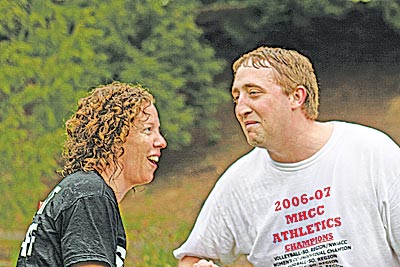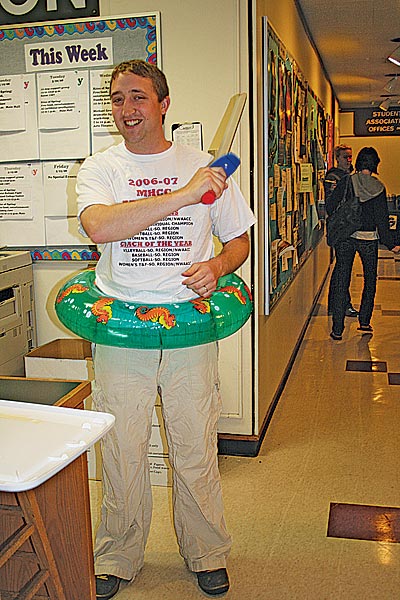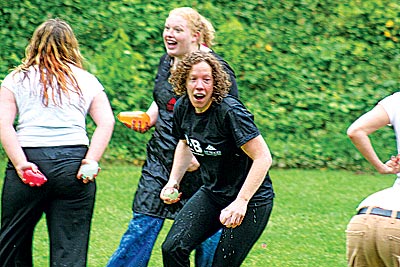Venture
June 2008



VENTURE
‘Gatekeepers’ bring new energy to College Center
Directors of Student Life look back at an event-filled year and prepare for next year
A wave of energy and ideas swept into the MHCC College Center 17 months ago as two key advisers began a new era in student activities that has been as creative and fun as the supervisors themselves.
Robert Cox, the director of Student Life, and Susan Adams, assistant director of Student Life, arrived that rainy January in 2007 and have made themselves quite at home with the Associated Student Government (ASG) and the Student Activities Board (SAB).
They started the year strong together and set high expectations for the ASG and SAB student leaders, said Cox.
“It was a fair and robust interview process,” Adams said. “We challenged the students in a supportive atmosphere.”
Cox said students at first did not think anyone would apply for the leadership positions because too much was being asked of them, but they were surprised when there were more applications than positions available.
“It’s competitive to get and keep these positions, but the students value the experiences,” Cox said.
When the two stepped on campus, they started by requiring mandatory training for ASG leaders and began rewriting the ASG bylaws. Students were warming up to them, according to Adams.
The bylaws were rewritten, the event approval process was changed, and student leaders were held responsible for maintaining their office hours, according to Cox.
“Robert and I agree that we set it up, but the students ran with it. They have the opportunity to change any (ASG) structure, policy, or make decisions to better the student body,” Adams said. “This is really their school and we hope it mirrors what a professional job is like.”
“Robert and I are just the gatekeepers” of student activities, Adams said.
Given the nature of their positions, they do mix and co-manage, but for the most part Cox is in charge of the ASG and the politically official side of the College Center. And Adams is in charge of the SAB and the student club part of the College Center.
“I have the policy type of position and Susan does clubs,” Cox said.
According to Adams, they also split their duties in the College Center vertically. Cox is in charge of the upstairs Fireplace Lounge and Adams is in charge of the downstairs game room area.
Cox said he likes helping Adams because student affairs can wear you out when you are working on your own. It is nice to be able to step back and enjoy helping, he said, although it is hard to give up so many nights and weekends.
Adams said they work together on issues involving leadership training, policy and College Center structural improvements, managing student leader needs, student success, and the center as a facility.
Cox said he heard a student say that there is a renewed energy on campus now. He added that the programs are doing well, and students are busy doing “their thing.”
Cox came from working directly with students on a daily basis to working more behind the scenes on the administrative side of things. In contrast, Adams came from working on the administrative side of recruiting students and is now working directly with them on a daily basis in student activities. The team has pulled together and made the College Center feel, as Cox says, “less sterile.”
Robert Cox
Director of Student Life steps back into policy role
Robert Cox came to MHCC after working as the student enrollment coordinator at the Washington State University-Vancouver campus. He supervised student government, outdoor recreation, the rental program, student ambassadors, co-curricular activities, the fitness center, athletics and more.
Cox left WSU-Vancouver on a Friday at 5 p.m. and drove to a MHCC ASG retreat in Corbett that evening. Cox said he had about an hour of transition time between jobs.
He discovered the MHCC opening because a former student was looking for a job in student affairs and asked him for help. While discussing some Oregon colleges with the student, he saw the Mt. Hood job description online.
“Sometimes the stars align,” Cox said. “It was a great decision and I have never looked back.”
His philosophy at MHCC is that these are all student-driven programs and are totally run by the student leaders.
In this past year he was involved in changing the ASG bylaws and forming a new elections committee. Cox said that he hopes that energy will carry over into next year.
Next year has started early for the College Center as Cox and Adams have ideas already brewing.
Cox said there is a need in the district to engage the high school students and to create a pipeline for them to come to Mt. Hood. Cox said there used to be programs that actively engaged with the high school students and he wants to bring them back.
He also wants to identify those populations not being served by current programs and activities and then focus on those kinds of programs (night students and parents, for example).
“We need to break the mold that successful programs have to happen on campus,” Cox said. “If we take the programs to the community, it will get students together to know each other and the community.”
According to Cox, the college should focus on getting people to campus but on getting people involved.
“It is just as important to get people involved as at the university level, even though it is harder here.”
At WSU-Vancouver, according to Cox, they held a major event each year that cost the school a lot of money but the students did not have to pay very much. One year they took a large group of students skiing.
Cox said these events created “a grass-roots type of explosion on campus.” As soon as some students got involved, the word spread like wildfire.
Cox said the Spring Dinner Dance in 2007 was MHCC’s attempt at that, and “it’s working. There were 100 more tickets sold this year.
“It’s a big bang for your buck,” Cox said. “MHCC is good at offering a broad spectrum of events and high quality ones, too.”
In terms of student initiative, Cox said two of the four of the tickets running for office in the 2008 ASG elections got involved because they saw posters for it. There are a lot of people aware now, and are engaged and are active on campus, Cox said.
“I hope it is an indicator of activity stirring on campus.” Cox said.
Cox has some long-term plans for the College Center. He said it currently doesn’t feel as sterile as it used to; it also has a more professional look now that they are fixing up the back of the Fireplace Lounge with the art gallery and Barney’s Pantry.
He said he wants it to have a big, comfortable feel.
Cox put up a neon “OPEN” sign glowing in the College Center window and said that new people walked in daily saying that they didn’t know they were open so late or that they were even there.
“Little things like that help promote us and get people to know we are here,” Cox said.
The MHCC administration is great about asking Cox to ask students what they want rather than asking him to speak for the students, he said.
“Kudos to the administration for that,” Cox said. “That is really helpful and it works pretty well here.”
Susan Adams
Assistant director of Student Life looks ahead to the coming year
Adams came to MHCC from Skagit Valley College where she was the international student recruiter. She was in charge of orientation programs and got to travel the world, but she quickly realized she was interested in working directly with students. “We have to figure out how we can provide co-curricular programs that meet the needs of a broad population.” Adams said.
When she first came to MHCC, her goal was to increase student involvement, student trust in the College Center and the staff, and in student leadership programs.
“I felt questioned by students when I first got here, but now I feel like they trust what we do,” Adams said. “We deliver what we promise.”
Adams said that when she first got here, she felt like a glass of water in the desert. She said the student leaders needed someone to listen to their ideas and, because of vacancies, they had no one to answer to and no one to take them seriously.
“We need to get the students’ trust in engaging in the programs,” she said. According to Adams, there are two levels of trust that must be created with the students. First, there must be trust in the program in order to apply for the positions, but then the trust to attend the events and get involved in clubs and activities.
“We have been able to increase involvement and marketing,” Adams said. “That is how we get people to notice that we are doing something — marketing.”
Adams said student activities provide the environment for dialogs to occur and for the college to feel like a home.
She said if students are involved, meeting new people and casually talking about similar interests, that’s how new clubs get started and new activities planned.
“If students get passionate about something, I want to let them run with it,” Adams said. “That is the beauty of my work.”
Adams said their number one priority to get people involved, and that is a constant challenge. She said it is a very different challenge than at a four-year college, Adams said. “Our programming and populations are much broader here.”
Adams said that next year she want to start assessing what different populations of students want and then work on how to meet those needs.
“Assessment must be ongoing because students are different from year to year,” Adams said.
“It is challenging, but implementing assessment is something I am going to be passionate about,” she said.
She said the college needs to do more family programming. She would like to see programs for parents to attend with their kids and or programming for parents to attend where there is child care available during the event.
But, she said, those needs must be assessed first.
Adams said the math club and the science club have really taken off and that students were the ones who created them. The math club was proposed by students, according to Adams, and the Science Club has now taken the initiative to try to break a Guinness world record.
Another plan is to perhaps shift one of the College Center’s supervisors to focus on sporting events, according to Adams, not the team sports but sporting activities that students can participate in if they are not able to play for the school.
She said it would be great to market these alternative-sporting events during halftime of varsity events.
She was also thinking about delegating some of that work to a new student leadership position: assistant director of marketing could be the title. But again, she said they would need to assess how students receive information best and how they can use that to access those students.
“After being here a year I can see where the needs are, but now I want to formally ask the questions,” Adams said, talking about assessing who, what, when, where and why students want and receive information.
Adams is in charge of the downstairs game room, but admits she has not done a good job with that this last year. Next year she plans to change things. She said she loves the ideas of a coffee shop scene, with low lighting, and thinks it would be a great complement to the recreational room.
She said she wanted to assess the needs of the gamers down there. She said most of them bring their own consoles, and she is thinking she might take the gaming area down to one TV instead of three to allow for alternative events to take place.
“My goal is to meet the needs of a broad audience and encourage more students to utilize that space.” Adams said.
She said she would love to have an acoustic stage and open mic in the game room, but notes that they would have to be careful not to disturb the offices in that area.
Adams said that she sets up student orientations and provides students with assistance but that the students run all the activities.
“That excites me. That is what makes my job really exciting.” Adams said. “That is being at the frontier and that showcases student life.”
Venture
June 2008


